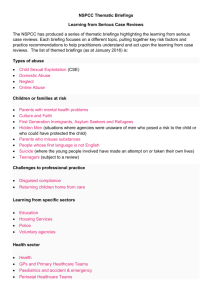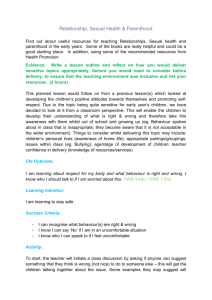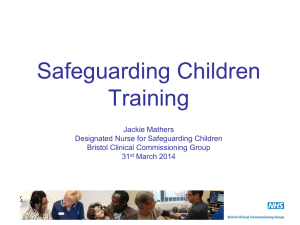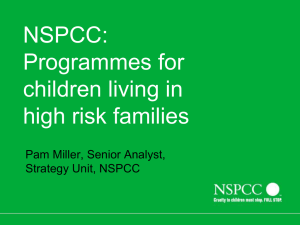A guide to implementing the Face to Face service
advertisement
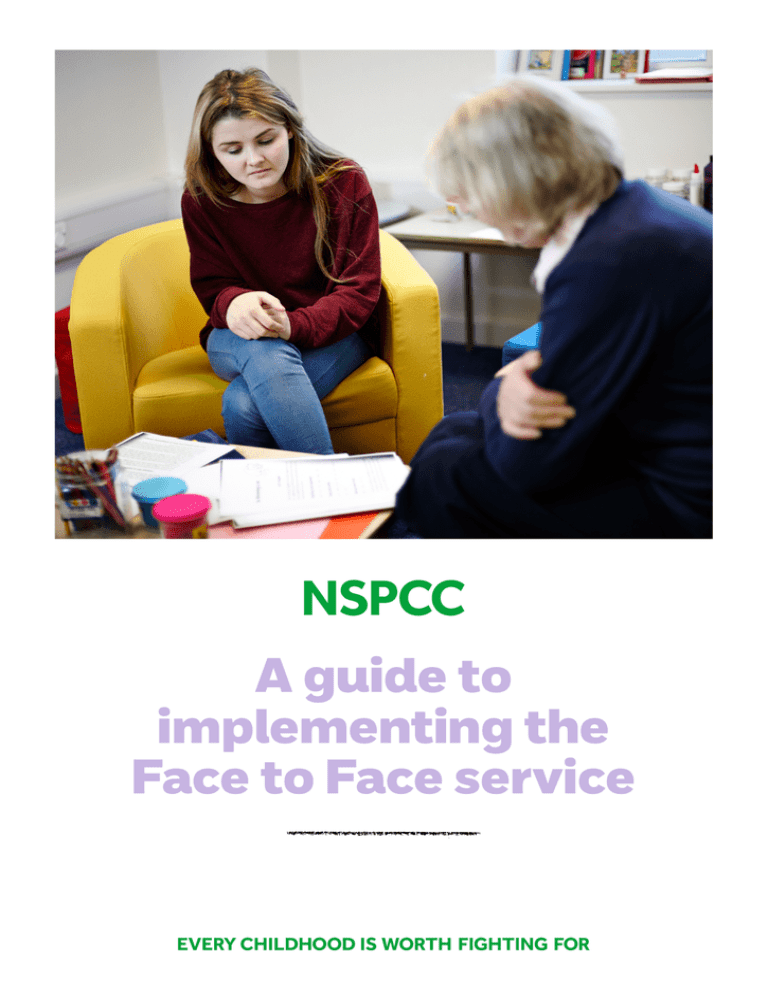
A guide to implementing the Face to Face service Introduction Face to Face is a service that helps children and young people aged 5–18 years who are in care or on the edge of care to cope with problems affecting their wellbeing. Using a solution- focused approach, it aims to help children and young people to improve their confidence and identify their skills and strengths so that they are better prepared to cope with problems now and in the future. This guide shares the NSPCC’s experience of delivering Face to Face, to inform those who would be interested in setting up a similar service. It explains what the Face to Face service offers and the benefits of providing this service. The information in this guide was drawn from the NSPCC practitioners delivering the service, administrative data collected during delivery and the findings from our evaluation. 2 Contents 1. The Face to Face service 1.1 1.2 1.3 Overview of the Face to Face service�������������������������������������������������������������������������������������������������������������������������������������������1 Background and rationale for developing the service���������������������������������������������������������������������������������������������������������1 Guiding principles of Face to Face�������������������������������������������������������������������������������������������������������������������������������������������������1 1 2. How we know Face to Face works 2 2.1 Evaluating Face to Face�����������������������������������������������������������������������������������������������������������������������������������������������������������������������2 2.2 Evaluation measures�����������������������������������������������������������������������������������������������������������������������������������������������������������������������������2 2.3 Summary of evaluation findings�����������������������������������������������������������������������������������������������������������������������������������������������������2 3. The benefits of Face to Face 3 3.1 Improved outcomes for children�����������������������������������������������������������������������������������������������������������������������������������������������������3 3.2 Benefits for referrers������������������������������������������������������������������������������������������������������������������������������������������������������������������������������3 3.3 Identification of previously unknown safeguarding issues����������������������������������������������������������������������������������������������4 4. Delivering Face to Face 5 4.1 Service delivery locations�������������������������������������������������������������������������������������������������������������������������������������������������������������������5 4.2 Eligibility criteria���������������������������������������������������������������������������������������������������������������������������������������������������������������������������������������5 4.3Referrals��������������������������������������������������������������������������������������������������������������������������������������������������������������������������������������������������������5 4.4 Making the service accessible���������������������������������������������������������������������������������������������������������������������������������������������������������5 4.5 The solution-focused approach������������������������������������������������������������������������������������������������������������������������������������������������������5 4.6 Embedding service evaluation���������������������������������������������������������������������������������������������������������������������������������������������������������6 4.7 Practitioners professional backgrounds������������������������������������������������������������������������������������������������������������������������������������6 4.8 Practitioner training�������������������������������������������������������������������������������������������������������������������������������������������������������������������������������6 4.9Caseloads����������������������������������������������������������������������������������������������������������������������������������������������������������������������������������������������������6 4.10 Supervision arrangements�����������������������������������������������������������������������������������������������������������������������������������������������������������������6 5. How children have used the service 7 5.1 Reasons for referrals������������������������������������������������������������������������������������������������������������������������������������������������������������������������������7 5.2 Frequency and number of sessions����������������������������������������������������������������������������������������������������������������������������������������������7 5.3 Demographics�������������������������������������������������������������������������������������������������������������������������������������������������������������������������������������������7 6. Position in the service landscape 6.1 6.2 6.3 6.4 Where referrals came from����������������������������������������������������������������������������������������������������������������������������������������������������������������8 Services accessed after Face to Face�����������������������������������������������������������������������������������������������������������������������������������������8 Services averted���������������������������������������������������������������������������������������������������������������������������������������������������������������������������������������8 Where Face to Face fits������������������������������������������������������������������������������������������������������������������������������������������������������������������������8 7. Costs 8 9 7.1 Cost of training in solution-focused practice.�������������������������������������������������������������������������������������������������������������������������� 9 7.2 Delivery costs��������������������������������������������������������������������������������������������������������������������������������������������������������������������������������������������9 Contact the NSPCC���������������������������������������������������������������������������������������������������������������������������������������������������������������������������������������������9 References 10 Appendix A: Children and young people eligible for the NSPCC’s Face to Face service��������������������������������������������11 Appendix B: Recording templates...................................... �����������������������������������������������������������������������������������������������������������������������12 1. The Face to Face service 1.1 Overview of the Face to Face service The NSPCC developed Face to Face to help children and young people in care or on the edge of care to cope with problems affecting their emotional health, safety or wellbeing. It uses a solution-focused approach to help young people improve their confidence and identify their skills and strengths so that they are better prepared to cope with problems now and in the future. 1.2 Background and rationale for developing the service Many looked after children have experienced abuse, neglect and severe family problems before they come into care. Research indicates that 45 per cent of children in care have a mental disorder (Meltzer et al, 2003); a rate that is four times higher than children in the general population (Ford et al, 2007). Care provides an opportunity for young people to feel safe and reshape their lives. However, studies have highlighted inadequate levels of support for looked after children (Hooper et al, 2007; Rees et al, 2010; Coy, 2009). In 2011, the NSPCC commissioned the Who Cares? Trust to consult with children in care about the kind of support service they would want to access. Views contributed by more than 270 looked after children and young people revealed that they wanted a service that would provide: • s upport from a person they can trust, who would listen and not judge • face to face support • quick access to support that was “not too heavy” • focus on their priorities, not what others a think they need • a tangible change in their situation. The NSPCC developed the Face to Face service to respond to these preferences. It offers a short-term, timelimited intervention using a solution-focused approach, and provides children and young people with a timely, confidential response. It focuses on the child’s priorities and aims to avoid the escalation of their difficulties to a level that may require more intensive support. The Face to Face service is not an alternative to long-term therapeutic support for looked after children but, recognising the lack of capacity in the current system, it was developed to explore the benefits of briefer forms of support. 1997), to suggest that solution-focused brief therapy is an effective approach for many children and young people. It has been used in a variety of settings, such as schools, youth services and prisons. Some features of the solution-focused approach are particularly child-friendly (Letham, 1994). The language used is concrete and focuses on “how/what/ when/where?” questions rather than “why?” It utilises children’s imaginations through their visualisation of a “preferred future”. The NSPCC sought to empower looked after children by taking an approach that regards them as “the expert” in their own life. Solution-focused practice provides children with an opportunity to build positive self-esteem by exploring their strengths and aspirations. 1.3 Guiding principles of Face to Face A set of guiding principles underpinned the NSPCC’s delivery of this service. Face to Face is “child-led”. The focus of the work was decided by the child or young person. It aimed to increase their sense of control over their life and their confidence to seek help from others. The service is offered promptly. The child or young person had initial contact from a practitioner as soon as possible; preferably within 24 hours of the referral. (It was not always possible for the NSPCC to make contact on the first attempt and, therefore, repeated attempts would be made over the 10 days following referral.) The service can be accessed by a young person independently of their carers. The practitioner had to be satisfied that the young person can give “informed consent”. The Fraser Guidelines were used in order to establish that: a) the young person can understand the professional’s advice; and b) cannot be persuaded to inform the person who has parental responsibility (Gillick vs West Norfolk, 1985). The service is confidential. Children were informed that the content of their sessions would not be discussed with anyone else without their permission, unless the practitioner was concerned that they or another child may be at risk. The NSPCC chose to use a solution-focused approach in the service as there is a large body of clinical research, particularly from the United States (Kiser, 1988; Kiser and Nunnely, 1990; De Jong and Berg, 1998; MacDonald, 1 2. How we know Face to Face works 2.1 Evaluating Face to Face The NSPCC evaluated the Face to Face service to test whether the service could help children and young people overcome the immediate problem that was impacting on their wellbeing. Face to Face was evaluated using a mixed-method design. The evaluation sample consisted of 611 children and young people. They completed outcome measures and questionnaires at the beginning and end of the service and at three months after using the service, to examine the extent to which improved outcomes for children and young people were achieved. Interviews were carried out with children and young people who completed the programme, foster carers, referrers and NSPCC practitioners to look in more depth at outcomes for children and experiences of the service. 2.2 Evaluation measures 2.3 Summary of evaluation findings Overall, children and young people who accessed Face to Face showed significantly improved wellbeing. There was no difference in outcomes based on the age of the child or whether the child had a learning disability or not. Children at risk of coming into care were more likely to have positive outcomes compared with those already in care. Children and young people said that the Face to Face service had helped. Similarly, referrers and foster carers found that the referral process was very easy and were able to see the changes in the children and young people. Further information can be found in the evaluation report for the Face to Face service, which is available on the NSPCC website: www.nspcc.org.uk/services-andresources/services-for-children-and-families/face-toface/face-to-face-evidence-impact-and-evaluation/ Children and young people completed the Outcome Rating Scale (ORS) at each session (Duncan et al, 2006). This is a four-item measure designed to track outcomes against four dimensions: • I ndividual: personal or symptomatic distress or wellbeing; • Interpersonal: the quality of the person’s relationships; • Social: the person’s view of satisfaction with work/school and relationships outside of the home; • Overall: a big picture or general sense of wellbeing. here is an equivalent version of this tool for children aged T 6–12 called the Child Outcome Rating Scale (CORS). The ORS and the CORS have numerical cut-off points; if a child scores above this point, it indicates they are experiencing clinical levels of distress. 2 3. The benefits of Face to Face “It was good because you were in control; some young people sit there and be worried about not wanting to go because they were letting someone down – you could make an appointment whenever you were feeling alright to go – knowing that helped me through the work.” Young person 3.1 I mproved outcomes for children The NSPCC’s evaluation showed that children and young people who accessed Face to Face benefited from a range of positive outcomes. Concerns impacting on children’s emotional wellbeing were addressed. Of the children and young people who participated in the evaluation of the Face to Face service, 73 per cent reported that it had helped “a lot” in addressing an immediate concern that had been impacting on their wellbeing. There was a reduction in clinical levels of distress. At the outset of the service, 58 per cent of children and young people had scores on the ORS indicating clinical levels of distress. By the end of the service, only 15 per cent of children and young people still had a clinical level of distress. This smaller group of of children may require longer term therapeutic support. Improvements in wellbeing continued after three months. The majority of children and young people still reported increased levels of wellbeing three months later, with only 16 per cent having experienced a deterioration in their wellbeing after three months. Children of all ages and learning ability had improved outcomes. There were no differences in outcomes based on the age of the children and young people or if they had a learning difficulty or not. This suggests that NSPCC practitioners were able to adapt the model to suit the needs of the child or young person. However, children at risk of coming into care were more likely to have positive outcomes compared with children already in care. The service was accessible and empowering to young people. Children and young people said that the Face to Face service had helped them achieve change by making them feel good about themselves and giving them practical things that they could do differently. Young people liked the flexibility that the service offered them. Giving young people a choice of how often they had their sessions and when they wanted to end the work helped give them a sense of control over the process. This supported their engagement with the Face to Face sessions. 3.2 Benefits for referrers Our evaluation of the Face to Face service showed that referrers and foster carers valued a number of things about it. The timeliness of the support. The quick referral process into the service meant that children and young people could receive timely support; an important factor that helped young people achieve positive outcomes. As one foster carer commented, it was important that they could access a service quickly once the young person had agreed to engage, otherwise they may have missed an opportunity for change. The accessibility of the service. Referrers valued the broad eligibility criteria, which made the service accessible to many vulnerable children and young people. “It was not a crisis situation but we had just got the young person to a point he was ready to talk to someone and then the social worker told us it would be take at least four months to see someone at [therapeutic service]. They then told us about the NSPCC service. I had not realised that I could make the referral myself. I called and the next week we had it all arranged as they did not have any waiting list – that was amazing.” Foster carer “It’s open, it’s not restrictive, there’s not a very restrictive criteria of who to refer other than that they’re looked after. There wasn’t an age restriction and it depended on what the young person wanted to bring into their session as well.” Children’s services social worker 3 Looked after children were more settled in their placements. Social workers who had referred young people noticed that they felt more settled into their placements after finishing the Face to Face sessions; especially those who had recently come into care. “Oh great, yes, we do appreciate what Face to Face has done to my young person because previously she used to refuse to get engaged into any activities at all and she was so adamant that she didn’t want to do anything at all but after working with Face to Face she’s now engaged in different activities, she’s now enrolled [on a] stage course. Yes she’s doing different activities, music, dancing and drummer, via Face to Face, yes.” Children’s services social worker Referrers and foster carers were able to see the changes in the child or young person. They also commented on the improved engagement of children and young people following the Face to Face service. “…it builds up that resilience in young people so they’re better able to deal with some of those issues going on in their respective lives…building resilience up helps them to look at the situation/situations in a different light, and I think sometimes we’re not the best-placed people to actually try and help that to happen.” Children’s services social worker The independence of the service. This was also noted to be an important feature of the Face to Face service by foster carers and referrers. Referrers and foster carers also highlighted the gap in services for any child or young person experiencing emotional difficulties. They suggested that Face to Face has a broader potential application to children and young people in a variety of settings, including schools. “…if he wanted to talk about things or if he wasn’t happy, he didn’t have to relate it to school because he was there every day for the next six years. He didn’t have to relate it to us because he was living with us, so it was that third party as well that he could talk and express things and I suppose come up with ideas and thoughts that would only…that in a sense he wouldn’t see [NSPCC worker] again, sort of thing, so it wasn’t the case that it was encroaching on his future either.” Foster carer 3.3 I dentification of previously unknown safeguarding issues Of the 1,354 eligible children and young people referred to the service, 86 were escalated to the local authority child protection services because significant safeguarding issues were identified. In many instances, these were issues that children and young people had not previously disclosed to professionals. During Face to Face sessions, children and young people disclosed incidents of physical abuse, neglectful parenting and sexual abuse, or incidents that indicated that child sexual exploitation was taking place. Mental health issues and self-harming were also identified. Therefore, by accessing an independent service provided by the NSPCC, looked after children and children on the edge of care were able to bring issues affecting their safety to the attention of child protection services. “For me, I see it as short, solution-focused work where a child can actually go and meet with someone independent of us and be able to have someone to talk to, to share their frustration and any difficulties they may have…having that opportunity for children to speak to someone outside of ourselves about their concerns.” Children’s services social worker 4 4. Delivering Face to Face 4.1 Service delivery locations The service was delivered from 18 locations across the UK between 2011 and 2015: Birmingham, Bristol, Croydon, East London, Foyle, Gillingham, Grimsby, Hull, Liverpool, Middlesbrough, Nottingham, Peterborough, Prestatyn, Sheffield, Southampton, Stoke on Trent, Swansea and Warrington. Not all sites were delivering the service for this entire duration. 4.2 Eligibility criteria The NSPCC offered the service to looked after children and young people and those on the edge of care. A full list of eligible groups is included in appendix A. Children and young people were not eligible for the Faceto Face service in the following circumstances: • here were immediate safeguarding concerns, T which had to be addressed before the child or young person accessed the service. • he child or young person required practical support T which would be better dealt with by an advocate. • he child or young person was involved in some T types of legal proceedings; for example, criminal proceedings where the young person was a witness. 4.3 Referrals Children and young people could access the Face to Face service in several ways: different aspects of the solution-focused approach. This toolkit is available on the NSPCC website: www.nspcc.org.uk/services-and-resources/researchand-resources/solution-focused-practice-toolkit/ 4.5 The solution-focused approach NSPCC practitioners who delivered the Face to Face service had attended a two-day training course in solution-focused practice (more on this below). The Face to Face service offered children and young people up to eight sessions of support using a solutionfocused approach. Practitioners were provided with a basic structure for sessions, which could be adapted to suit the needs of the individual young person. Children and young people were offered additional sessions if there were safeguarding concerns still outstanding that required further support. Face to Face support sessions with children and young people included the following elements: Problem-free talk. At the outset of the work, the practitioner invited the child to describe their likes and strengths. This provided a positive start to the work and communicated to the child that there is more to them than just the problem. These identified aspects of the child’s resilience would be drawn on in later parts of the work. Establishing what the child wants. At the outset of the work, the child or young person identified their “best hopes” for the work. This became the focus of the child and practitioner’s work together. • ith the support of a carer, social worker or w other professional • independently if they were assessed to be competent according to the Fraser guidelines Describing what is wanted in detail. This is often referred to as the child’s “preferred future”. The child or young person described in detail what the future would look like when they have moved toward their best hopes. Children and young people needed to be of an age or ability that enabled them to understand the nature of the service and to “choose” to refer/be referred to it. Working toward the preferred future. The child or young person identified behaviours and activities that were helping them move towards their preferred future. 4.4 Making the service accessible Additional support through interpreters and signers was provided to children where they needed it to access the service. NSPCC practitioners were encouraged to develop creative approaches for communicating the solutionfocused approach to children of varying ages, interests and needs. To share these creative approaches, the NSPCC developed a toolkit for using solution-focused practice with children and young people. The toolkit presents NSPCC practitioners’ ideas for worksheets and activities that help to engage children and young people with Planning and working toward endings. The practitioner was clear about their particular role in the child or young person’s life and the number of sessions available to them. The child or young person was prepared for their sessions coming to an end. Building on success. The most important work often took place between sessions when the child or young person put what they had learned into practice in real life situations. They reflected on their achievements at each session. Identifying the solution team. These are people in the child or young person’s life who support them and can help them work toward achieving their best hopes. Helping the child to identify their support network was often an important feature of the work. 5 4.6 Embedding service evaluation 4.8 Practitioner training The evaluation of the Face to Face service was integrated into the delivery of the work. Children completed the Outcome Rating Scale (ORS) or Child Outcome Rating Scale (CORS), at the start of each session.1 The NSPCC gave staff two days of training in solutionfocused practice. Training was delivered by Guy Shennan, an independent consultant. 2 The ORS and CORS provided a baseline measure of the child or young person’s wellbeing at the outset of the work. This enabled comparison with later sessions to measure the extent to which the intervention supported the child or young person to reach their goals. Children also completed a Session Rating Scale (SRS) at the end of each session, giving the child the opportunity to feed back to the practitioner about the quality of the support they received. This information was used by NSPCC practitioners to understand how they could better support the child or young person. However, the SRS information did not contribute to the NSPCC’s formal evaluation. The training introduced NSPCC practitioners to the basic principles of the solution-focused approach. It gave them opportunities to discuss these techniques and consider how they would apply them in the context of the Face to Face service. Participants were given exercises to complete and used role-play to begin putting the solution-focused approach into practice. 4.9 Caseloads Each NSPCC practitioner worked with an average caseload of 10 children and young people at any one time. However, this varied across sites, with some sites working with caseloads of up to 13. 4.7 Practitioners professional backgrounds 4.10 Supervision arrangements The service was delivered by NSPCC practitioners who came from a range of professional backgrounds. Some practitioners had previously worked as social workers in local authority children’s services. A number of practitioners had worked in a range of residential care settings. Other practitioners came from youth work backgrounds or other areas like community development, adult community mental health services, asylum seeker and refugee services, or services for unemployed youth or the long-term unemployed. Practitioners were supervised by their line managers. These supervisors found that it was helpful to have a good understanding of key aspects of the solution- focused approach. Some supervisors attended the two-day introductory training course, and the NSPCC also provided a one-day training workshop for team managers who did not have previous experience of solution-focused practice. Most of the practitioners had social work qualifications. In some areas, there were also student social workers delivering the service. The supervision process needs to provide two elements: a) educative support to the practitioner in using the approach; and b) the use of solution-focused questions within the supervisory process, to provide the experience of “doing”. Practitioners held a range of qualifications, including degrees in social work, psychology, social policy, youth work and childhood studies. Many practitioners had also completed training in a range of therapeutic and counselling approaches, and had experience in delivering therapeutic work with children. Practitioners received additional support to develop their practice through monthly peer-support teleconferences. Chaired by an experienced manager, these teleconferences brought practitioners together to share their practice experience and suggest solutions to difficulties arising in their work. Practitioners found that it was helpful to use a recording template to generate practice reflection from a solutionfocused perspective (see appendix B). Practitioners were encouraged to use this template within the supervision exchange. 2 Guy Shennan and Associates. See: www.sfpractice.co.uk 6 5.How children have used the service 5.1 Reasons for referrals 5.3 Demographics Children and young people accessed the Face to Face service for a range of reasons. The NSPCC carried out case file analysis on a sample of 86 children and young people to identify the goals that they had chosen to work towards. The goals most frequently identified by children and young people who used Face to Face included: Similar numbers of male and female children and young people accessed the service; 49 per cent were female, 47 per cent were male, and information about gender was not obtained for 3 per cent of cases. Most of the children were aged between 13 and 19 years (54 per cent), 30 per cent were aged between nine and 12 years, and 15 per cent were aged between five and eight years. An age was not recorded for 1 per cent of children and young people referred to the service. • eveloping safer strategies to cope with emotions D like anger, rejection, isolation, loss or anxiety, and managing associated behavioural issues • Increasing their self-confidence • Being able to engage in healthy relationships • Better learning in school • I mproving communication with professionals in their life, including foster carers, family members or siblings 5.2 Frequency and number of sessions Children were given the flexibility to decide how frequently they would like their sessions to occur. Most children had their sessions on a weekly or fortnightly basis. Some children chose to space out their sessions more toward the end, to give them longer to practise the techniques they had learned between sessions. The majority of children and young people who accessed the service were White (77 per cent), 8 per cent were of Mixed heritage, 4 per cent were Black or Black British, 3 per cent were Asian or Asian British, and 15 children were from other ethnic groups. Ethnicity was not recorded for 7 per cent of the children and young people referred to the service. A disability was recorded for 16 per cent of the 1,354 eligible children and young people referred to the service. Within this group, 7 per cent of those children and young people were recorded as having a learning difficulty and 6 per cent were recorded as having behavioural, emotional and social development needs. On average, the NSPCC worked with children and young people for 17 weeks, but this varied from site to site, ranging from 13 weeks to 21 weeks. The average number of sessions that children and young people accessed was eight. 7 6. Position in the service landscape 6.1 Where referrals came from The majority of referrals came from local authority children’s services (63 per cent) but children and young people were also referred from schools (9 per cent), health services (4 per cent) and by carers (3 per cent), and 5 per cent of children and young people referred themselves. NSPCC practitioners promoted the Face to Face service through a broad range of engagement activities, including attending children’s social care management meetings, offering drop-ins at schools or children’s homes and talking to foster carers at support group meetings. “I always knew I should talk to someone when I was worried but I was scared to try. But those sessions just made me try. I feel a better person as now I can talk more to people. If I had something bothering me I can go and talk to them because before I couldn’t have done that because I would have felt nobody’s listening, who cares? But now I know there’s people out there that do care and do want to help me. So I feel a better person for managing to talk.” Young person 6.2 S ervices accessed after Face to Face As part of the evaluation of Face to Face, a sample of 119 children and young people were followed up after three months of completing the service. During this follow up, children and young people were asked to complete the ORS (103 of the 119 completed this) as well as answer a short survey. Children and young people were also asked about the services they had accessed since finishing the Face to Face work. Half of the young people in the follow-up sample identified support that they were receiving from children’s services, child and adolescent mental health services (CAMHS), or other counselling services. In the evaluation of Face to Face, children and young people reported that they were more willing to ask for and accept help. Prior to the Face to Face service, some young people felt that they would push other people away as they did not believe that talking would really make a difference. However, after the Face to Face work they felt more confident and had a greater motivation to talk about their concerns and feelings. This greater confidence in help-seeking and trust in professionals meant that Face to Face facilitated some young people’s engagement of other services that they may not have previously accessed, such as CAMHS. 6.3 Services averted Evaluation findings showed that at the end of the service only 15 per cent of children and young people were still in a clinical level of distress (rather than 58 per cent at the outset), indicating the need for further therapeutic support. Referrers noted some examples of young people who no longer needed further long-term support after they had accessed the Face to Face service. In one instance, a young person had addressed the loss of a key relationship to such an extent that the referrer had withdrawn them from the CAMHS waiting list that they had been on for a month. In another example, the referrer observed a significant reduction in a young person’s challenging behaviour at school after accessing the Face to Face service. This meant that the young person was able to continue in mainstream education, negating the need for any special educational arrangements for them. 6.4 Where Face to Face fits The NSPCC sees the Face to Face service as fitting into an integrated service offer for looked after children or other vulnerable young people who require support with their emotional wellbeing. In some areas where the NSPCC has offered Face to Face, it has been used to provide quick-access support for looked after children on a waiting list for longer-term therapeutic services from CAMHS. Face to Face might be offered to young people who want additional support, but whose needs do not necessarily warrant a specialist service. In one area, Face to Face was offered on a routine basis to all children and young people entering care. The NSPCC has also found Face to Face to be effective in supporting young people with more challenging needs, such as self-harm. Therefore, Face to Face can be helpful to children and young people with a wide range of needs, from low-level difficulties with their wellbeing to more serious emotional and behavioural problems. 8 7.Costs Contact the NSPCC 7.1 Cost of training in solution-focused practice If you would like more information about any aspect of the Face to Face service, please contact Louise Bazalgette, NSPCC Development Manager. NSPCC practitioners attended a two-day training course in solution-focused practice. It cost the NSPCC under £2,000 to provide this basic training to 24 NSPCC practitioners and the trainer also offered trained staff on- going email consultation. Email: louise.bazalgette@nspcc.org.uk Phone: 020 3772 9030 The NSPCC’s lead evaluator provided internal evaluation training, to introduce practitioners to the ORS and CORS evaluation measures used in this service. 7.2 Delivery costs The cost of delivering the Face to Face service was the equivalent to the salaries of one full-time practitioner (working with 10 children and young people on average) and associated line management and administrative costs. We have estimated our costs to be approximately £1,000 per child or young person accessing the service. Evaluation measures are free to use for individual purposes but for organisational use there is a fee of $100 for a licence. Measures can be purchased via the Heart and Soul of Change website: www. heartandsoulofchange.com The practice toolkit developed by the NSPCC, which includes worksheets and activities to be used in service delivery, is available free of charge on the NSPCC website: www.nspcc.org.uk/services-and-resources/researchand-resources/solution-focused-practice-toolkit/ 9 References Coy, M. (2009) “Moved around like bags of rubbish nobody wants”: how multiple placement moves make young women vulnerable to sexual exploitation. Child Abuse Review, 18(4), pp.254–266 De Jong, P., and Berg, I. K. (1998) Interviewing for solutions. Pacific Grove, CA, USA: Brooks/Cole Duncan, B. L., Sparks, J., Miller, S. D., Bohanske, R., and Claud, D. (2006) Giving youth a voice: A preliminary study of the reliability and validity of a brief outcome measure for children, adolescents, and caretakers. Journal of Brief Therapy, 5, pp.66–82 Ford, T., Vostanis, P., Meltzer, H., and Goodman, R. (2007) Psychiatric disorder among British children looked after by local authorities: Comparison with children living in private households. The British Journal of Psychiatry, 190(4), pp.319–325 Gillick v West Norfolk & Wisbech Area Health Authority (1985) UKHL 7. British and Irish Legal Information Institute (BAILII). More information is available on the NSPCC website: www.nspcc. org.uk/preventing-abuse/child-protection-system/legal-definition-child-rights-law/gillickcompetency-fraser-guidelines/ Hooper, C.A., Gorin, S., Cabral, C., and Dyson, C. (2007) Living with Hardship 24/7: the diverse experiences of families in poverty in England. York: The Frank Buttle Trust Kiser, D. (1988) A follow-up study conducted at the BriefFamily Therapy Center. Unpublished manuscript. Kiser, D., & Nunnally, E. (1990). The relationship between treatment length and goal achievement in solution-focused therapy. Unpublished manuscript. Letham, J. (1994) Moved to Tears, Moved to Action: BriefTherapy with Women and Children. London: BT Press Macdonald, A. J. (1997) Brief therapy in adult psychiatry: Further outcomes. Journal of Family Therapy, 19, pp.213–222 Meltzer, H., Corbin, T., Gatward, R., Goodman, R., and Ford, T. (2003) The mental health of young people looked-after by local authorities in England. Office for National Statistics, London: HMSO Rees, G., Bradshaw, J., Goswami, H., and Keung, A. (2010) Understanding Children’s Well-being: A National Survey of Young People’s Well-being. London: The Children’s Society 10 Appendix A: Children and young people eligible for the NSPCC’s Face to Face service The NSPCC offered the Face to Face service to the following groups of children and young people: • Looked after children • C hildren and young people in kinship care (care of extended family) • C hildren who are privately fostered (cared for by someone who is not a parent or ‘close relative’ for 28 days or more) • C hildren and young people in custody/secure immigration centres • Children currently at risk of coming into care • C hildren who have recently returned home from care • C hildren who have recently run away from home (or care) • Adopted children • Care leavers (aged up to 19 at the time of the referral) 11 Appendix B: Recording templates: First session Name:Session no:Date:ORS completed: Competency talk What do you enjoy? What are you good at? What does it take to be good at that? Desired outcome What are your best hopes from our work? How would you know it had been useful? What difference are you hoping it will make? What would you notice different about yourself, if this were helpful? Preferred future description Suppose you woke up tomorrow and… Scale rating (if asked) Definition of scale: 10 = 0 = Details of instances (of the preferred future) already in place, past successes, progress What tells you it is at that point and not 0? What else? What difference is that making? How did you do that? What did that take? etc Small signs of further progress What would tell you/others you were a point higher? What might you be doing (differently, more of)? Summary/feedback/suggestion given: Other significant issues arising? Another session? Date & time planned: SRS completed: 12 Appendix B: Recording templates: Follow up session Name:Session no:Date:ORS completed: Progress What’s better? What have you/others noticed? What differences has that made? etc Helpful actions How did you do that ? etc. NB if ‘worse’ - Coping questions; How have you stopped it getting worse? etc Qualities (strengths, skills, resources) What did that take? What does that say about you? What have you learned about yourself? Scale Good enough? If yes, consider asking a confidence scale Signs of further progress What would you/others notice if you were moving further up the scale? One point up the scale? What would you be doing (differently)? What else might you do? Summary Suggestion given? Noticing suggestion; Keep on doing what’s working; other Anything else arising Another session? Date & time planned: SRS completed: 13 © 2015 NSPCC. Photography by Jon Challicom. The adult is a volunteer and the child is a model. Find out more about our work at nspcc.org.uk Registered charity England and Wales 216401. Scotland SC037717.



